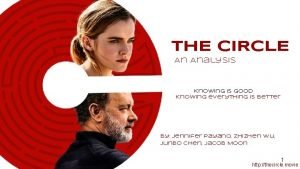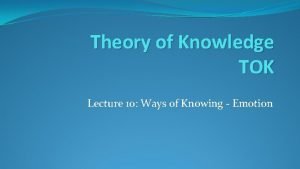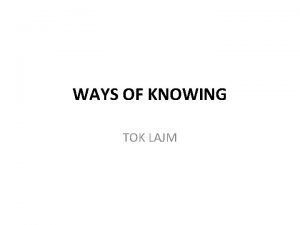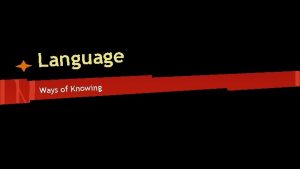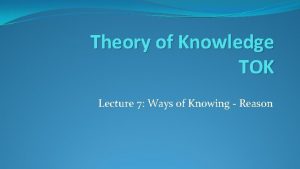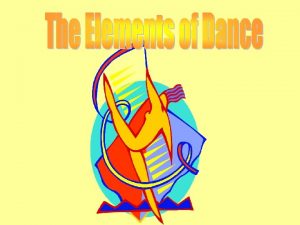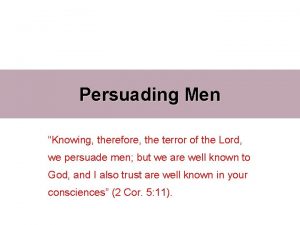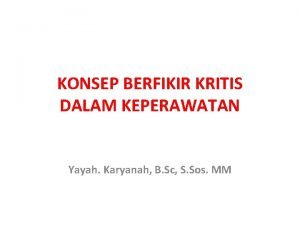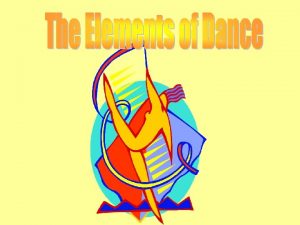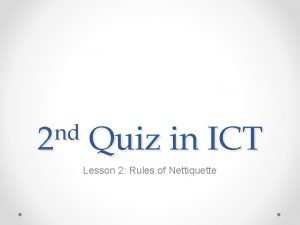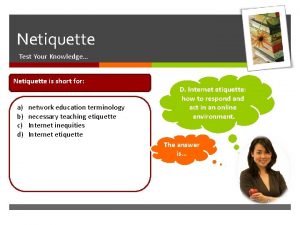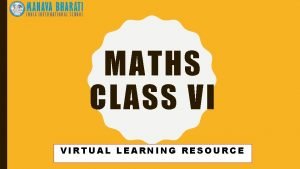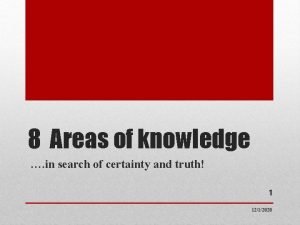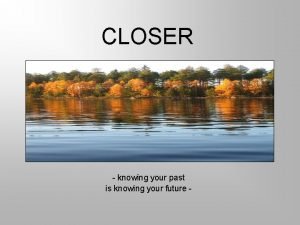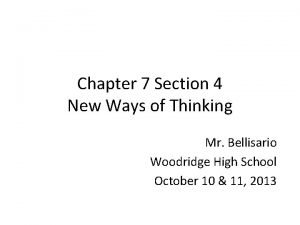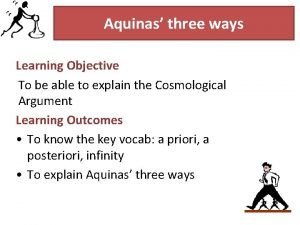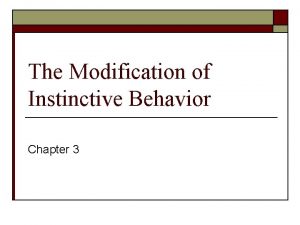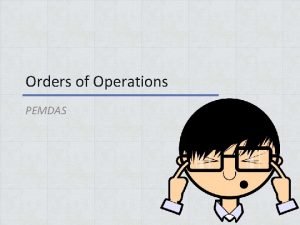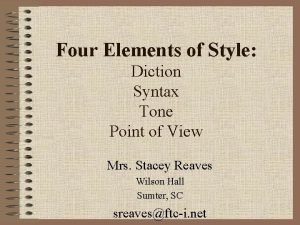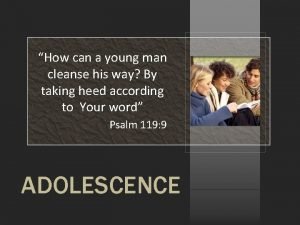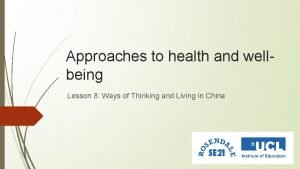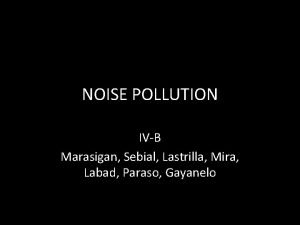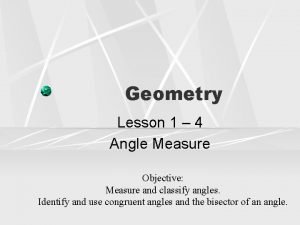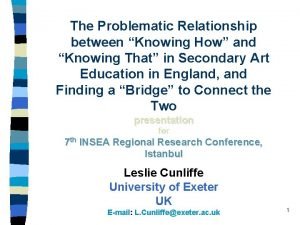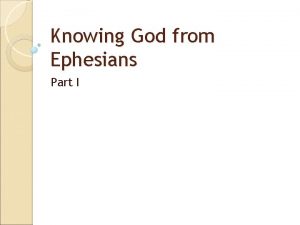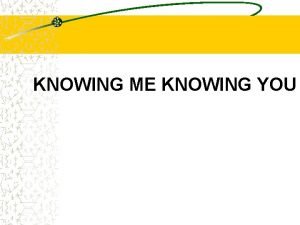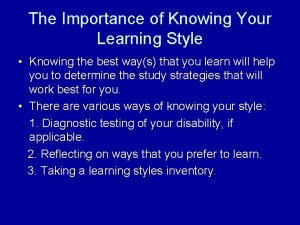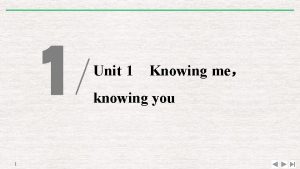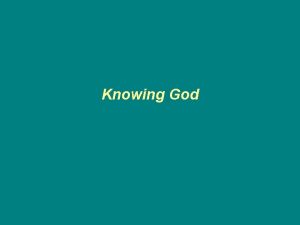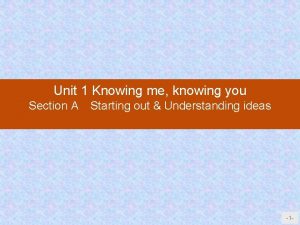Ways of Knowing Ways of knowing Ways of












































![The Allegory of the Cave from Book VII of The Republic [Socrates: ] … The Allegory of the Cave from Book VII of The Republic [Socrates: ] …](https://slidetodoc.com/presentation_image_h2/5a2cbee673f92a3a9caf652cf71da67c/image-45.jpg)







![[Socrates: ] And now look again, and see what will naturally follow if the [Socrates: ] And now look again, and see what will naturally follow if the](https://slidetodoc.com/presentation_image_h2/5a2cbee673f92a3a9caf652cf71da67c/image-53.jpg)

![Socrates' conclusion, as expressed by Plato [Socrates: ] This entire allegory, I said, you Socrates' conclusion, as expressed by Plato [Socrates: ] This entire allegory, I said, you](https://slidetodoc.com/presentation_image_h2/5a2cbee673f92a3a9caf652cf71da67c/image-55.jpg)


- Slides: 57

Ways of Knowing Ways of knowing

Ways of Knowing Language

Ways of Knowing Reason

Ways of Knowing Emotion

Ways of Knowing Perception

Perception

Perception

Perception

• Did you notice that one leprechaun, in going from 14 to 15 leprechauns, lost a knee-cap?

• Another guy got the knee-cap, but gave up a foot.

• So what is happening, is in going from 14 to 15, the 14 guys each give up a small piece of themselves. If 14 guys give up 1/14 th of themselves that equals one whole new guy!

• Try rearranging the leprechauns in the order of giveand-take. Start with the knee-cap-loser. Then comes the knee-cap-gainer/foot-loser. Then the chap who gained that foot, and so on. This continues to a little man with crossed arms who acquires hair.

• Instead of three pieces, the below image has two pieces - top and bottom. Slide the bottom over, giving the second man the first man's knee. What do we find?

Perception

Perception

Perception

Perception

Perception

Perception

Perception Tractor Perspective Illusion - Optical Illusion Image Gallery #33

Electromagnetic spectrum

Visible light

Visible light λ ≈ 700 nm λ ≈ 420 nm

Ultraviolet waves λ ≈ 700 - 420 nm

Ultraviolet waves λ ≈ 700 - 420 nm λ ≈ 10 – 100 nm

X-rays λ ≈ 700 - 420 nm λ ≈ 10 – 100 nm

X-rays λ ≈ 700 - 420 nm λ ≈ 10 – 100 nm λ ≈ 1 – 0. 01 nm

Gamma rays λ ≈ 700 - 420 nm λ ≈ 10 – 100 nm λ ≈ 1 – 0. 01 nm

Gamma rays λ ≈ 700 - 420 nm λ ≈ 10 – 100 nm λ ≈ 1 – 0. 01 nm λ ≈ 10 -12 - 10 -14 m

Infrared waves λ ≈ 700 - 420 nm λ ≈ 10 – 100 nm λ ≈ 1 – 0. 01 nm λ ≈ 10 -12 - 10 -14 m

Infrared waves λ ≈ 700 - 420 nm λ ≈ 10 – 100 nm λ ≈ 10 -4 - 10 -6 m λ ≈ 1 – 0. 01 nm λ ≈ 10 -12 - 10 -14 m

Microwaves λ ≈ 700 - 420 nm λ ≈ 10 -4 - 10 -6 m λ ≈ 10 – 100 nm λ ≈ 1 – 0. 01 nm λ ≈ 10 -12 - 10 -14 m

Microwaves λ ≈ 700 - 420 nm λ ≈ 10 -4 - 10 -6 m λ≈ 10 -2 - 10 -3 m λ ≈ 10 – 100 nm λ ≈ 1 – 0. 01 nm λ ≈ 10 -12 - 10 -14 m

Radio waves λ ≈ 700 - 420 nm λ ≈ 10 -4 - 10 -6 m λ ≈ 10 -2 - 10 -3 m λ ≈ 10 – 100 nm λ ≈ 1 – 0. 01 nm λ ≈ 10 -12 - 10 -14 m

Radio waves λ ≈ 700 - 420 nm λ ≈ 10 -4 - 10 -6 m λ ≈ 10 -2 - 10 -3 m λ ≈ 10 -1 - 103 m λ ≈ 10 – 100 nm λ ≈ 1 – 0. 01 nm λ ≈ 10 -12 - 10 -14 m

Electromagnetic spectrum λ ≈ 700 - 420 nm λ ≈ 10 -4 - 10 -6 m λ ≈ 10 -2 - 10 -3 m λ ≈ 10 -1 - 103 m λ ≈ 10 – 100 nm λ ≈ 1 – 0. 01 nm λ ≈ 10 -12 - 10 -14 m

Electromagnetic spectrum Long Wavelength Short Wavelength

Electromagnetic spectrum Long Wavelength Low Frequency Short Wavelength High Frequency

What do they all have in common? λ ≈ 700 - 420 nm λ ≈ 10 -4 - 10 -6 m λ ≈ 10 -2 - 10 -3 m λ ≈ 10 -1 - 103 m λ ≈ 10 – 100 nm λ ≈ 1 – 0. 01 nm λ ≈ 10 -12 - 10 -14 m

What do they all have in common? • They can travel in a vacuum • They travel at 3 x 108 m. s-1 in a vacuum (the speed of light) • They are transverse • They are electromagnetic waves (electric and magnetic fields at right angles to each oscillating perpendicularly to the direction of energy transfer)

The Allegory of the Cave by ancient Greek philosopher Plato (429 -347 BC) Is not the dreamer, sleeping or waking, one who likens dissimilar things, who puts the copy in place of the real object? - Plato

Plato Opened a school on the outskirts of Athens dedicated to the Socratic search for wisdom. Plato's school, then known as the Academy, was the first university in western history and operated from 387 B. C. until A. D. 529, when it was closed by the Roman Emperor Justinian. Plato was both a writer and a teacher. His writings are in the form of dialogues, with Socrates as the principal speaker. This discussion format has become known as Socratic dialogue.

Plato’s theory of Forms The visible world is what surrounds us: what we see, what we hear, what we experience; this visible world is a world of change and uncertainty. The intelligible world is made up of the unchanging products of human reason: anything arising from reason alone, such as abstract definitions or mathematics, makes up this intelligible world, which is the world of reality. The intelligible world contains the eternal "Forms" (in Greek, idea ) of things.

The visible world is the imperfect and changing manifestation in this world of these unchanging forms. For example, the "Form" or "Idea" of a horse is intelligible, abstract, and applies to all horses; this Form never changes, even though horses vary wildly among themselves—the Form of a horse would never change even if every horse in the world were to vanish. An individual horse is a physical, changing object that can easily cease to be a horse (if, for instance, it's dropped out of a fifty story building); the Form of a horse, or "horseness, " never changes. As a physical object, a horse only makes sense in that it can be referred to the "Form" or "Idea" of horseness. Plato realizes that the general run of humankind can think, and speak, etc. , without (so far as they acknowledge) any awareness of his realm of Forms.
![The Allegory of the Cave from Book VII of The Republic Socrates The Allegory of the Cave from Book VII of The Republic [Socrates: ] …](https://slidetodoc.com/presentation_image_h2/5a2cbee673f92a3a9caf652cf71da67c/image-45.jpg)
The Allegory of the Cave from Book VII of The Republic [Socrates: ] … let me show in a figure how far our nature is enlightened or unenlightened: --Behold! human beings living in a underground den, which has a mouth open towards the light and reaching all along the den; here they have been from their childhood, and have their legs and necks chained so that they cannot move, and can only see before them, being prevented by the chains from turning round their heads. Above and behind them a fire is blazing at a distance, and between the fire and the prisoners there is a raised way; and you will see, if you look, a low wall built along the way, like the screen which marionette players have in front of them, over which they show the puppets. [Glaucon: ] I see.

And do you see, I said, men passing along the wall carrying all sorts of vessels, and statues and figures of animals made of wood and stone and various materials, which appear over the wall? Some of them are talking, others silent. You have shown me a strange image, and they are strange prisoners. Like ourselves, I replied; and they see only their own shadows, or the shadows of one another, which the fire throws on the opposite wall of the cave? True, he said; how could they see anything but the shadows if they were never allowed to move their heads? And of the objects which are being carried in like manner they would only see the shadows? Yes, he said. And if they were able to converse with one another, would they not suppose that they were naming what was actually before them? … No question, he replied. To them, I said, the truth would be literally nothing but the shadows of the images. That is certain.

How does Plato’s thought experiment work? Sketch your own interpretation of the cave • In plan • Side-on • or • With perspective

In The Allegory of the Cave, Plato likens people untutored in the Theory of Forms to prisoners chained in a cave, unable to turn their heads. All they can see is the wall of the cave. Behind them burns a fire. Between the fire and the prisoners there is a parapet, along which puppeteers can walk. The puppeteers, who are behind the prisoners, hold up puppets that cast shadows on the wall of the cave. The prisoners are unable to see these puppets, the real objects, that pass behind them. What the prisoners see and hear are shadows and echoes cast by objects that they do not see.

http: //www. youtube. com/wat ch? v=TYKNAdbh. Qw&feature=related

Such prisoners would mistake appearance for reality. They would think the things they see on the wall (the shadows) were real; they would know nothing of the real causes of the shadows. So when the prisoners talk, what are they talking about? If an object (a book, let us say) is carried past behind them, and it casts a shadow on the wall, and a prisoner says “I see a book, ” what is he talking about? He thinks he is talking about a book, but he is really talking about a shadow. But he uses the word “book. ” What does that refer to? Plato’s answer was: “And if they could talk to one another, don’t you think they’d suppose that the names they used applied to the things they see passing before them? ” Couldn’t it be the same for us, fooled by our senses into thinking that we perceived reality, when in truth it is just a shadow of the intelligible world?

Plato’s point is that the prisoners would be mistaken. For they would be taking the terms in their language to refer to the shadows that pass before their eyes, rather than (as is correct, in Plato’s view) to the real things that cast the shadows. If a prisoner says “That’s a book” he thinks that the word “book” refers to the very thing he is looking at. But he would be wrong. He’s only looking at a shadow. The real referent of the word “book” he cannot see. To see it, he would have to turn his head around.

Plato’s point: the general terms of our language are not “names” of the physical objects that we can see. They are actually names of things that we cannot see, things that we can only grasp with the mind. The prisoners may learn what a book is by their experience with shadows of books. But they would be mistaken if they thought that the word “book” refers to something that any of them has ever seen. Likewise, we may acquire concepts by our perceptual experience of physical objects. But we would be mistaken if we thought that the concepts that we grasp were on the same level as the things we perceive. Suppose now that one of the men escaped, and got out of the cave, and saw what real people looked like, and real trees and grass. If he went back to the cave and told the other men what he had seen, would they believe him, or would they think he was crazy? http: //www. historyforkids. org/learn/greeks/philosophy/plato. htm http: //www. youtube. com/watch? v=1 Fdakl. Iy. VVY&feature=related
![Socrates And now look again and see what will naturally follow if the [Socrates: ] And now look again, and see what will naturally follow if the](https://slidetodoc.com/presentation_image_h2/5a2cbee673f92a3a9caf652cf71da67c/image-53.jpg)
[Socrates: ] And now look again, and see what will naturally follow if the prisoners are released and disabused of their error. At first, when any of them is liberated and compelled suddenly to stand up and turn his neck round and walk and look towards the light, he will suffer sharp pains; the glare will distress him, and he will be unable to see the realities of which in his former state he had seen the shadows; and then conceive some one saying to him, that what he saw before was an illusion, but that now, when he is approaching nearer to being and his eye is turned towards more real existence, he has a clearer vision, -what will be his reply? And you may further imagine that his instructor is pointing to the objects as they pass and requiring him to name them, -- will he not be perplexed? Will he not fancy that the shadows which he formerly saw are truer than the objects which are now shown to him? [Glaucon: ] Far truer. [Socrates: ] And if he is compelled to look straight at the light, will he not have a pain in his eyes which will make him turn away to take and take in the objects of vision which he can see, and which he will conceive to be in reality clearer than the things which are now being shown to him? [Glaucon: ] True, he said. [Socrates: ] And suppose once more, that he is reluctantly dragged up a steep and rugged ascent, and held fast until he 's forced into the presence of the sun himself, is he not likely to be pained and irritated? When he approaches the light his eyes will be dazzled, and he will not be able to see anything at all of what are now called realities.

When the prisoners are released, they can turn their heads and see the real objects. Then they realize their error. What can we do that is analogous to turning our heads and seeing the causes of the shadows? Plato says that we are like those men sitting in the cave: we think we understand the real world, but because we are trapped in our bodies we can see only the shadows on the wall. One of his goals is to help us understand the real world better, by finding ways to predict or understand the real world even without being able to see it. We can come to grasp the true Forms with our minds.
![Socrates conclusion as expressed by Plato Socrates This entire allegory I said you Socrates' conclusion, as expressed by Plato [Socrates: ] This entire allegory, I said, you](https://slidetodoc.com/presentation_image_h2/5a2cbee673f92a3a9caf652cf71da67c/image-55.jpg)
Socrates' conclusion, as expressed by Plato [Socrates: ] This entire allegory, I said, you may now append, dear Glaucon, to the previous argument; the prison-house is the world of sight, the light of the fire is the sun, and you will not misapprehend me if you interpret the journey upwards to be the ascent of the soul into the intellectual world …. But, whether true or false, my opinion is that in the world of knowledge the idea of good appears last of all, and is seen only with an effort; and, when seen, is also inferred to be the universal author of all things beautiful and right… and the immediate source of reason and truth in the intellectual; and that this is the power upon which he who would act rationally, either in public or private life must have his eye fixed. …. Whereas, our argument shows that the power and capacity of learning exists in the soul already; and that just as the eye was unable to turn from darkness to light without the whole body, so too the instrument of knowledge can only by the movement of the whole soul be turned from the world of becoming into that of being, and learn by degrees to endure the sight of being, and of the brightest and best of being, or in other words, of the good.

In conclusion The Allegory presents, in brief form, most of Plato's major philosophical assumptions: his belief that the world revealed by our senses is not the real world but only a poor copy of it, and that the real world can only be apprehended intellectually; his idea that knowledge cannot be transferred from teacher to student, but rather that education consists in directing student's minds toward what is real and important and allowing them to apprehend it for themselves; his faith that the universe ultimately is good; his conviction that enlightened individuals have an obligation to the rest of society, and that a good society must be one in which the truly wise (the Philosopher-King) are the rulers. Full text at: http: //webspace. ship. edu/cgboer/platoscave. html Or http: //www. historyguide. org/intellect/allegory. html

The key knowledge issues for us are: • the world revealed by our senses is not the real world but only a poor copy of it (our sensory organs are limited, but also our mental ability to interpret what the brain receives is limited) • real world can only be apprehended intellectually (in our minds) • this requires active thought: we need to direct our minds toward what is real and important and to apprehend it for ourselves (not be shown) How valuable is this model of knowledge acquisition?
 Not knowing is worse than knowing
Not knowing is worse than knowing Circle of knowing
Circle of knowing Ee tok matrix 2022
Ee tok matrix 2022 Tok ways of knowing
Tok ways of knowing Eight ways of knowing
Eight ways of knowing Language
Language Hypothetico deductive reasoning
Hypothetico deductive reasoning Language as a way of knowing
Language as a way of knowing Gods ways are not our ways
Gods ways are not our ways Nature of knowledge and knowing
Nature of knowledge and knowing Knowing where you stand
Knowing where you stand Does god know me personally
Does god know me personally Ranktrack
Ranktrack Knowing your audience
Knowing your audience The area of space occupied by the dancer's body
The area of space occupied by the dancer's body Knowing the terror of the lord we persuade
Knowing the terror of the lord we persuade Apa itu berpikir kritis
Apa itu berpikir kritis Growingknowing
Growingknowing Knowing style
Knowing style Thinking is better than knowing
Thinking is better than knowing The gift of knowing you
The gift of knowing you Growing knowing
Growing knowing Bound and free movements
Bound and free movements A program designed to send advertisements mostly pop-ups
A program designed to send advertisements mostly pop-ups Faith is knowing the sun will rise
Faith is knowing the sun will rise Knowing my community
Knowing my community Knowing netiquette will help you to
Knowing netiquette will help you to Importance of knowing the history
Importance of knowing the history 最美的祝福
最美的祝福 Introduction of knowing our numbers
Introduction of knowing our numbers Areas of knowing
Areas of knowing Knowing the bible 101
Knowing the bible 101 Emotion as a way of knowing
Emotion as a way of knowing Knowing your future
Knowing your future Knowing more remembering more
Knowing more remembering more Konsep nilai moral dan norma
Konsep nilai moral dan norma Cask of amontillado questions
Cask of amontillado questions Four ways in which ones
Four ways in which ones Chapter 7 section 4 new ways of thinking
Chapter 7 section 4 new ways of thinking Assessing grammar effectively
Assessing grammar effectively Chapter 21 section 1 changing ways of life
Chapter 21 section 1 changing ways of life In many different ways
In many different ways Aquinas three ways
Aquinas three ways Mention two ways of modification of instinct.
Mention two ways of modification of instinct. Three different ways humans regionalize the earth
Three different ways humans regionalize the earth Ways to show respect to others
Ways to show respect to others Pemdas sayings
Pemdas sayings Adjective to describe diction
Adjective to describe diction Kilit ampule
Kilit ampule Factor quadratic equations
Factor quadratic equations How can a young man cleanse his ways
How can a young man cleanse his ways 8 ways to wellbeing
8 ways to wellbeing Useful and harmful materials picture
Useful and harmful materials picture What are ways to install and maintain equipment
What are ways to install and maintain equipment Obvious ways values enter psychology
Obvious ways values enter psychology The two ways
The two ways Noise pollution control
Noise pollution control Lesson 1-4 angle measure
Lesson 1-4 angle measure

